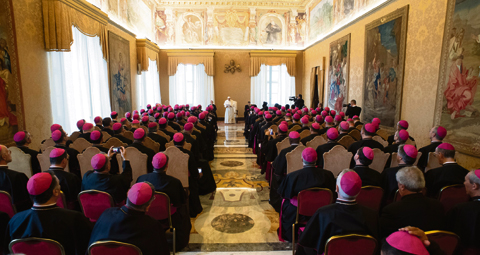BY Ryan McDougall | August 9 | ![]() 0 COMMENTS
0 COMMENTS ![]() print
print

Delving into apostolic history like tracing a family tree
Gerald Warner shines a light on apostolic succession and its pivotal role in our Church.
Long ago, as a young man, I stayed briefly at a language school in Ireland run by an émigré Russian nobleman. He and I used to spend the evenings discussing history.
One night he told me that when he was a boy in 1913, during the Tercentenary celebrations of the Romanov dynasty, his father had presented him to Tsar Nicholas II, who shook hands with him.
Nicholas II
“And now, my friend,” the Count said, extending his hand, “I shall shake hands with you and for the rest of your life you will be able to say you shook hands with someone who had shaken the hand of Nicholas II.” And we solemnly exchanged a handshake.
Years later, it occurred to me that this whimsical gesture, establishing a minor link with an historical character, might serve as a metaphor for something altogether more serious and awe-inspiring: the apostolic succession which is the root of the Church’s authority. The four marks of the True Church are that she is One, Holy, Catholic and Apostolic.
Church authority
That apostolic character, deriving from the power and teaching transmitted by the apostles, is the source of the Church’s authority. It is particularly manifested in the episcopal succession, as each bishop is consecrated by the laying on of hands by an existing bishop whose remote predecessor was similarly consecrated by an apostle who had himself received his authority from God the Son in person. It is an awesome thought.
That apostolic authority is necessary for the valid administration of all the Sacraments, except Baptism and marriage.
Sacraments
Even the schismatic Orthodox churches have valid orders and sacraments, though the Protestant denominations do not, since in the 16th century they abandoned the apostolic rites of ordination and episcopal consecration. Anglican pretensions to apostolic succession were conclusively dismissed by Pope Leo XIII in Apostolicae Curae, in which he condemned such claims as ‘absolutely invalid and utterly void.’
Priests, of course, also participate in the apostolic succession since they are ordained by a bishop in that lineage. Although all 12 apostles—including Judas’ successor St Matthias—must have laid consecrating hands on bishops in different regions of the early Church, the vicissitudes of history have caused the episcopal lineage to expand and contract, just like a physical family, over two millennia.
Lineage
Today there are approaching 5,200 bishops in the Church.
Surprisingly, 95 per cent of them trace their episcopal lineage back to bishops consecrated by one man in the 16th century: Cardinal Scipione Rebiba, titular Patriarch of Constantinople who in the course of his career consecrated 23 bishops.
One of the later bishops who traced his episcopal descent from Cardinal Rebiba was Pope Benedict XIII and since he consecrated at least 139 bishops to serve all over the world it is easy to see how the Rebiba ‘family’ expanded.
Ancestry
As a matter of historical curiosity some clergy and lay researchers have investigated the sacramental ancestry of many bishops.
It is possible to construct an episcopal version of the popular genealogy programme Who Do You Think You Are?
Take one example. Today, the Archbishop of New York, a major archdiocese, is Cardinal Timothy Dolan. He was consecrated a bishop by Archbishop Rigali of Saint Louis, Missouri.
Sacramental grandson
But Archbishop Rigali was himself consecrated by Pope John Paul II, making Cardinal Dolan a sacramental ‘grandson’ of a pope who was also canonised.
From a Scottish perspective there is a further historical interest in St John Paul II’s episcopal genealogy since his consecration descended, nine generations back, from Cardinal Henry Stuart, Duke of York (inset left), younger brother of Bonnie Prince Charlie, known to Jacobites as King Henry IX.
Cardinal York’s mother, Princess Clementina Sobieska, was the granddaughter of King John III Sobieski of Poland, so it was historically appropriate he should have furnished a link between the apostles and the first Polish pope.
The Stuart dynasty
Since Cardinal York—himself 10 episcopal generations in descent from the ubiquitous Cardinal Rebiba—consecrated 23 bishops, including the future Popes Clement XIV and Pius VI, a large number of bishops today trace their consecration from the last of the Stuarts who, as his dynasty ended, promoted the growth of a more enduring spiritual family.
The next largest traceable ‘family’ after Rebiba’s is the succession of bishops consecrated by Cardinal d’Estouteville in the 15th century. He consecrated six, including Pope Sixtus IV, and Popes Julius II and Leo X were in this line of succession, as are 17 bishops serving in France today.
It should be emphasised that gaps in ancient records in no way place a question mark over episcopal consecrations centuries ago: there were far fewer bishops then and all consecrations were most rigorously monitored by the Church authorities.
Every diocesan ordinary today has a valid sacramental descent from the apostles who were themselves consecrated by our Saviour.










